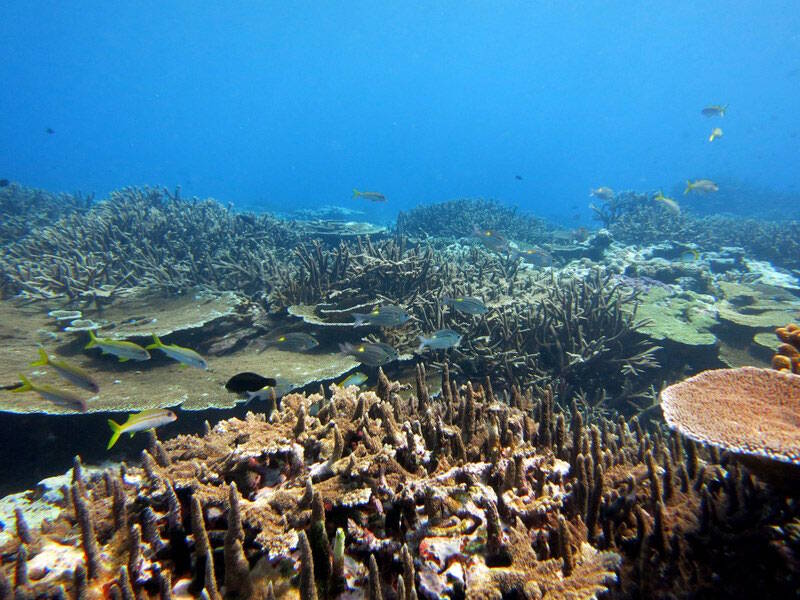
By Mareike Sudek, Research Coordinator, National Marine Sanctuary of American Samoa

Shallow-water reef habitat of Fagetele Bay (around 10 meters depth) showing a thriving coral community. Image courtesy of NOAA National Marine Sanctuary of American Samoa. Download larger version (jpg, 164 KB).
National Marine Sanctuary of American Samoa encompasses 13,581 square miles of marine waters, ranging from shallow coral reef habitat (0-30 meters) to deep, offshore areas that contain fascinating mesophotic (30-200 meters) and deep-sea (below 200 meters) habitats. The sanctuary includes six protected areas. Of those, Aunu’u contains rich shallow coral reefs and a large zone of deep bottomfish habitat; Fagatele Bay and Fagalua/Fogama’a contain shallow reefs as well as submarine canyons; and Muliāva contains the greatest area of deep-sea habitats (to 5,000 meters), including Vailulu’u and Malulu seamounts.
Deepwater and shallow-water ecosystems share certain fundamental ecological qualities but they also show some major differences. For a long time, scientists believed that corals were only found in shallow, sunlit, warm-water ecosystems. However, recent deep-sea explorations revealed that coral can also thrive in deep, dark, cold waters up to 3,000 meters deep. Especially in the mesophotic zone and on seamounts, these coral gardens can be as diverse and flourishing as their shallow counterparts. Mesophotic reef camera tow surveys around Tutuila and the Manu’a islands have revealed a variety of habitats, including hard coral reefs, sea fan beds, and rocky barrens.
In both shallow and deep-ocean ecosystems, hard corals as well as soft corals can create the framework which other reef biota needs to survive. One of the most conspicuous differences, however, is that deep-sea corals do not have the same tiny algae cells (zooxanthellae) in their tissue that shallow-water and mesophotic corals contain. Deep-sea corals are therefore often referred to as “azooxanthellate” coral. Shallow-water and mesophotic corals rely heavily on sunlight for nutrition (the zooxanthellae convert the light to food), whereas deep-sea corals rely on filtering particles out of the water column to survive.

Mesophotic reef habitat (around 50 - 60 meters) in American Samoa showing thriving coral population. Image courtesy of NOAA PIFSC CREP. Download larger version (jpg, 187 KB).
Shallow coral reefs support a wide variety of species of fish and invertebrates and are considered biodiversity hotspots. For example, Fagatele Bay is characterized by a diverse and flourishing coral community. Deeper reefs function in the same way and are considered an important habitat for bottomfish and many other sea creatures. Mesophotic reefs may even act as deepwater refuges and nurseries for a variety of species that usually inhabit shallower reefs.
Populations in the deeper reefs are less likely to be affected by environmental stressors and so are more protected from mortality events. It is thought that larvae from mesophotic populations could settle in the shallower reefs and so help repopulate degraded shallow ecosystems. In addition, many shallow species of coral and other reef biota also extend into deeper mesophotic areas and so populate a variety of different depths (usually down to about 150 meters). Because of this important connection, it is essential that both shallow and deeper habitats be protected. With this in mind, National Marine Sanctuary of American Samoa covers a variety of marine ecosystems ranging from shallow to deep water.
Another very important connection between deepwater habitats and shallow-water habitats is what is called “diel vertical migration.” Every day, a variety of animals including zooplankton, squid, and certain fish species, start migrating upwards at dusk and spend the night in the shallow ocean layers to feed. At dawn, they migrate back down into the deep ocean to avoid daytime predators. All this happens because of tiny algae (phytoplankton) that live in the top sunlit layers of the ocean. Zooplankton feed on phytoplankton so they migrate upwards to feed. It is thought that certain fish species follow their zooplankton prey to the surface. However, not all deep-water fish migrate vertically. In some species, only part of the population migrates, and other species don’t migrate at all. Scientists still don’t fully understand why diel vertical migration happens and there is still much to discover to explain all the intricacies of this process.
Overall, a lot more is known about shallow water reefs because they are much easier and cheaper to survey. For example, the species composition of fish and coral in the shallow sanctuary areas are well documented, whereas species diversity in the deeper mesophotic and deep-sea areas are poorly understood. However, recent efforts in deep-sea exploration have revealed fascinating discoveries and further expeditions, such as the 2017 American Samoa expedition, are trying to unveil many more secrets of the deep.